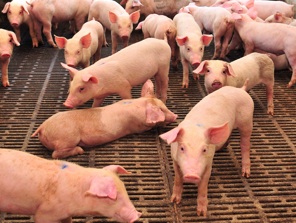
News
Research aims to predict phosphorus output from swine
January 30, 2009 by Manitoba Livestock Manure Management Initiative
 NEWS HIGHLIGHT
NEWS HIGHLIGHT
Research aims to predict phosphorus output from swine
A new research project hopes to
develop a way to accurately estimate the amount of phosphorous being
excreted in pig manure.
January 30, 2009, Winnipeg, Man. – A new research project hopes to develop a way to accurately estimate the amount of phosphorous being excreted in pig manure.
 The objective of the project, being funded in part by the Manitoba Livestock Manure Management Initiative (MLMMI), is to collect data from individual sows under highly controlled conditions, and employ mathematical models to assess the output of phosphorous in their manure. The data will be used to evaluate an existing model used by Manitoba Conservation that predicts phosphorous output from swine operations. It is anticipated that the results of this project will assist Manitoba swine producers in nutrient management planning.
The objective of the project, being funded in part by the Manitoba Livestock Manure Management Initiative (MLMMI), is to collect data from individual sows under highly controlled conditions, and employ mathematical models to assess the output of phosphorous in their manure. The data will be used to evaluate an existing model used by Manitoba Conservation that predicts phosphorous output from swine operations. It is anticipated that the results of this project will assist Manitoba swine producers in nutrient management planning.
The two-year study began in August 2008 and is run by Dr. Ermias Kebreab, a Canada Research Chair at the University of Manitoba. The experimental phase of the trial has recently been completed, and sample analysis is now underway. The modeling and model evaluation portion of the project will follow completion of sample analysis.
The full report – entitled “Nutrient Management Planning for Sow Operations Using Extant and New Feed Consumption Models and Manure Analysis” – is available on the MLMMI’s website at www.manure.mb.ca.
Monogastric animals (like swine) do not have the ability to use all of the phosphorus they consume in their diet because they do not produce enough of the enzyme phytase that breaks it down in the gastrointestinal tract. So, to meet the phosphorous requirements of these animals, addition of inorganic phosphorus to the diet has become common practice. However, any extra phosphorous added to the diet beyond what is required by the animal usually ends up in the manure, and that can result in leaching to ground water and eutrophication of water bodies if not managed properly.
Various feeding strategies have been recommended to reduce phosphorous output in manure. One approach is to add phytase to the diet in order to enable the animal to better utilize the phosphorous that is fed to them. This minimizes the amount of phosphorous that is excreted in the manure.
Public awareness of environmental pollution is putting pressure on the swine industry to address the issue of ground and surface water contamination by manure nutrients. This perceived problem has led to a moratorium on construction and expansion of swine operations in certain areas of Manitoba. Accurate estimation of phosphorous output in manure and proper nutrient management planning is critical for future sustainability and further development of the swine industry.
For more information on the MLMMI or its projects, please visit www.manure.mb.ca, or contact Brandy Street, executive director, by phone at (204) 945-2122, or by email at Brandy.Street@gov.mb.ca.